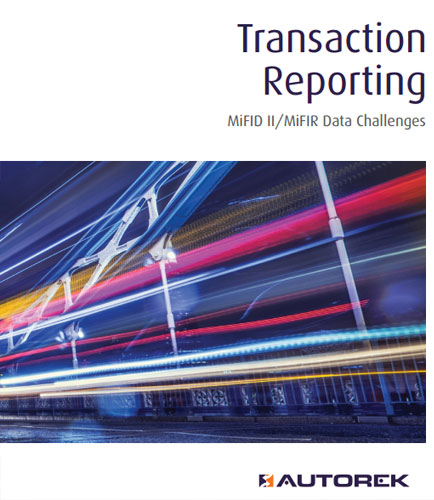
PROCESSING. PLEASE WAIT...


White Paper: AutoRek
Transaction Reporting is one of the key priorities for regulators. Some are already warning that there will be no latitude for non-compliance, including late reporting. The aim of Transaction Reporting is to assist EU regulators in the detection and investigation of suspected market abuse.
By implementing a robust, automated financial control regime, investments firms will ensure readiness for the significant changes MiFID II/MiFIR will have in respect of Transaction Reporting requirements.
Currently there is divergence across Europe and the member states, in respect of the application of existing transaction reporting obligations. MiFID II is seeking to harmonise Transaction Reporting so that there is a more consistent approach.
This whitepaper focuses on Transaction Reporting and how a robust, automated financial control regime can overcome often manual and complex reporting processes, hence ensuring on-going compliance, including:
MiFID II Timeline and the need to prepare now
Changes from the existing MiFID I requirements
AutoRek's 5 step approach to Transaction Reporting

By: HighRoads
Each year, HighRoads surveys companies about their current processes and future plans for compliance communications. In 2013, HighRoads invited mid- to large-sized organizations throughout the United States to share information about their compliance and governance operations; their approach to producing, updating and distributing Summary Plan Descriptions (SPD) and the steps they are taking to generate the Summary of Benefits and Coverage (SBC) and other required notices under the Affordable Care Act (ACA). Benefits communication straddles an unusual line between the everchanging requirements of government regulation, the increasing need for clear, concise and understandable content and changing preferences for how to receive and send information. That said, there are some things that remain constant from year to year-such as what employers find most challenging and the lack of good data around compliance expenditures.
By: AutoRek
In the present scenario, it is very difficult to achieve CASS compliance without the correct CASS governance and oversight framework in place. Most firms with CASS failings painfully resolve their issues only to find more problems down the line, despite all the costs and resources that they would have dedicated to resolving the initial failings. Often this is due to the lack of focus on building a sustainability framework that is forward looking, rather than incident driven. But what does 'Good CASS Governance' even look like? Few firms or consultants can explain what good governance looks like or provide a tangible solution; a lack of clarity in the market exists even before the myriad of CASS arrangements have been added to the equation. This whitepaper provides insights on what firms need to do in order to manage CASS risk and build a robust CASS governance structure. It highlights: Good Governance: The Key to CASS Compliance Personal accountability and Tougher CASS audits The importance of centralized processes and controls Risk management using 'tangible' governance tools A 'Governance Wheel' of CASS governance's critical elements The danger of 'sticking plaster solutions' How Rosediem and AutoRek can help


 2025 All Rights Reserved | by: www.ciowhitepapersreview.com
2025 All Rights Reserved | by: www.ciowhitepapersreview.com